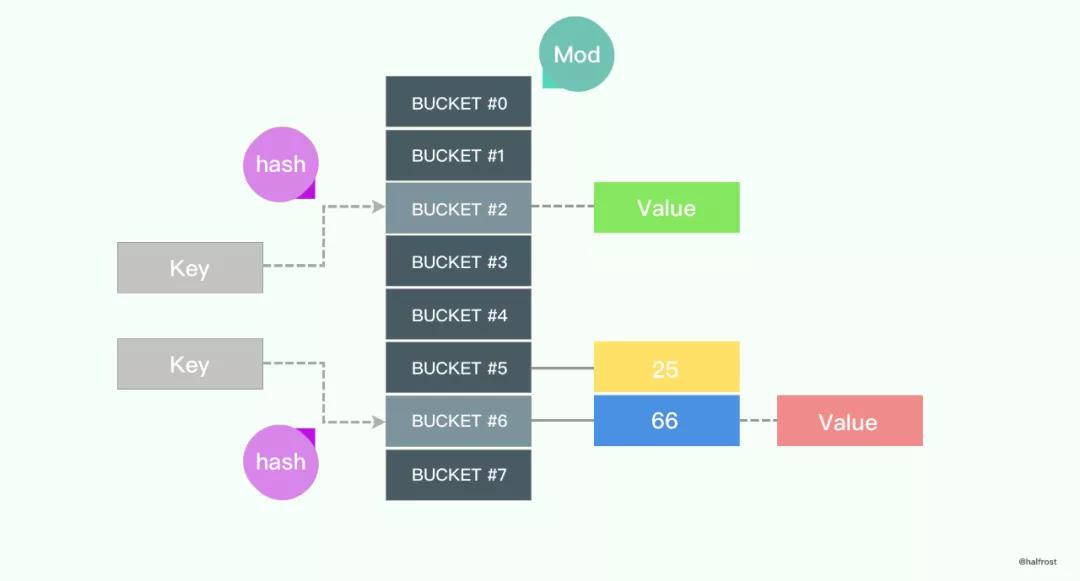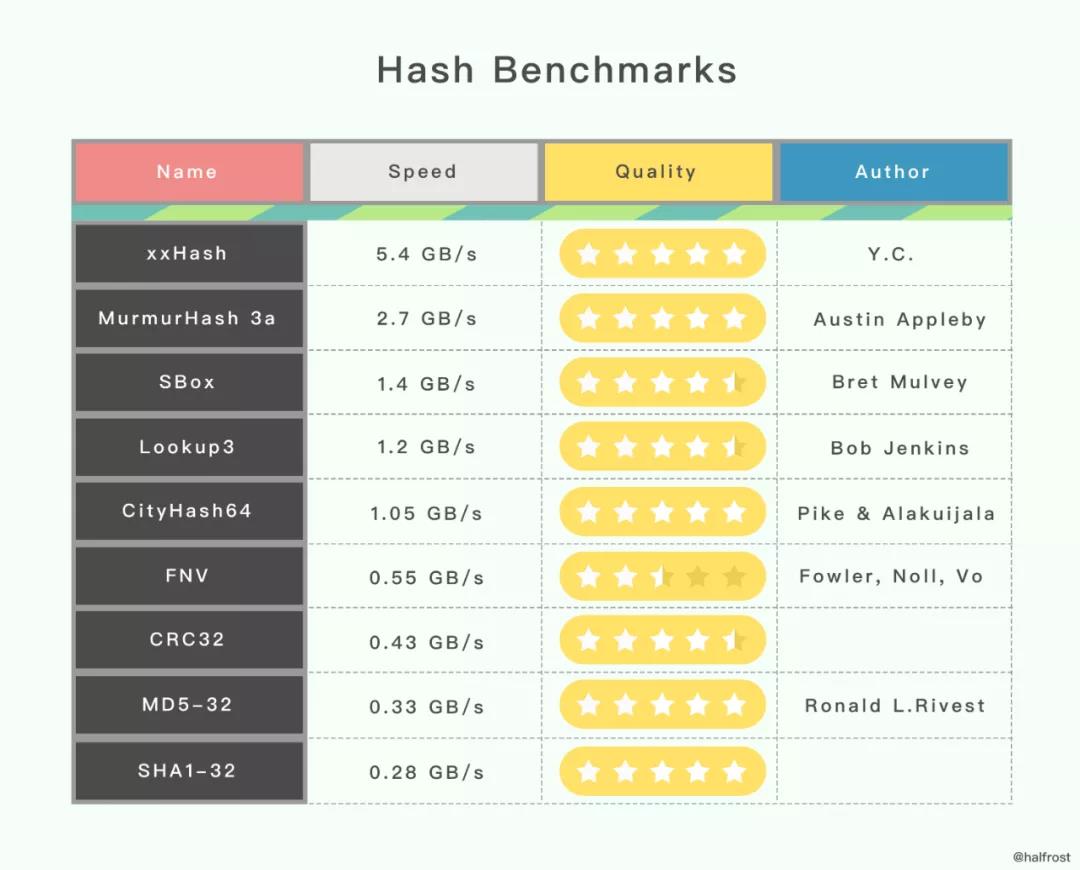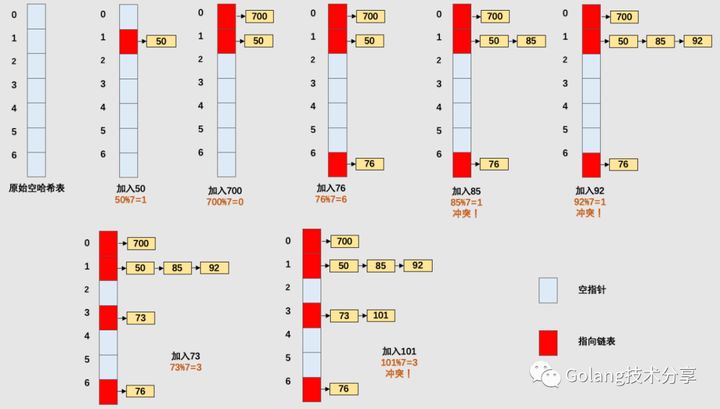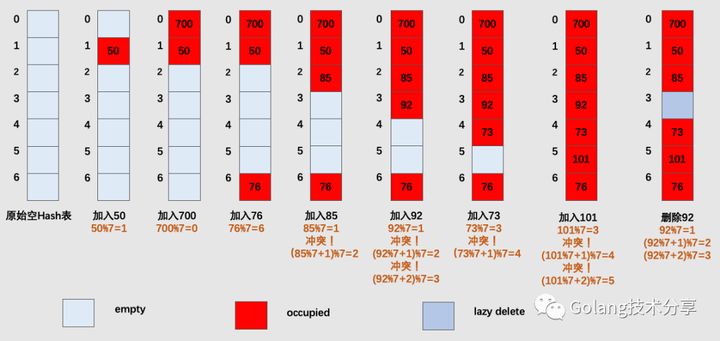什么是map?
map的特点:
- Map 是一个无序的 key/value 集合;
- Map 中所有的 key 都是不同的;
- 通过给定的 key ,可以在常数时间复杂度内查找、更新或删除相应的 value
想要实现一个性能优异的 Map,需要关注以下三个关键点:
对于给定的 key,先进行哈希运算得到哈希值,然后按 Map 长度取模,将 key 映射到指定的位置,最后取得相应的 value。

哈希算法
哈希算法有以下特点:
- 如果两个哈希值不同,那么这两个哈希值对应的原始输入肯定不同;
- 如果两个哈希值相同,那么这两个哈希值对应的原始输入可能相同,也可能不同(这种情况称为"哈希冲突/哈希碰撞/散列碰撞")。
常见的哈希算法:

速度与质量排序:

Golang 使用的哈希算法
Golang 选择哈希算法时,根据 CPU 是否支持 AES 指令集进行判断 ,如果 CPU 支持 AES 指令集,则使用 Aes Hash,否则使用memhash。
AES Hash:AES 指令集全称是高级加密标准指令集(或称英特尔高级加密标准新指令,简称AES-NI),是一个 x86指令集架构的扩展,用于 Intel 和 AMD 处理器。
利用 AES 指令集实现哈希算法性能很优秀,因为它能提供硬件加速。
相关代码:
runtime/alg.go
asm_amd64.s
asm_arm64.s
memhash:网上没有找到这个哈希算法的作者信息,只在 Golang 的源码中有这几行注释,说它的灵感来源于 xxhash 和 cityhash。
相关代码:
runtime/hash64.go
runtime/hash32.go
处理哈希冲突
问题:不同的key可能会产生相同的哈希值
解决方法:链地址法和开放地址法
链地址法:

开放地址法:

对于开放寻址法而言,它只有数组一种数据结构就可完成存储,继承了数组的优点,对CPU缓存友好,易于序列化操作。但是它对内存的利用率不如链地址法,且发生冲突时代价更高。当数据量明确、装载因子小,适合采用开放寻址法。
链表节点可以在需要时再创建,不必像开放寻址法那样事先申请好足够内存,因此链地址法对于内存的利用率会比开方寻址法高。链地址法对装载因子的容忍度会更高,并且适合存储大对象、大数据量的哈希表。而且相较于开放寻址法,它更加灵活,支持更多的优化策略,比如可采用红黑树代替链表。但是链地址法需要额外的空间来存储指针。
值得一提的是,在Python中dict在发生哈希冲突时采用的开放寻址法,而java的HashMap采用的是链地址法。
在Go语言中使用链地址法(存疑:有一说是开放寻址法)
扩容策略
两个概念:哈希桶与装载因子
哈希桶:哈希桶(也称为槽,类似于抽屉原理中的一个抽屉)可以先简单理解为一个哈希值,所有的哈希值组成了哈希空间。
装载因子:装载因子是表示哈希表中元素的填满程度。它的计算公式:装载因子=填入哈希表中的元素个数/哈希表的长度。装载因子越大,填入的元素越多,空间利用率就越高,但发生哈希冲突的几率就变大。反之,装载因子越小,填入的元素越少,冲突发生的几率减小,但空间浪费也会变得更多,而且还会提高扩容操作的次数。装载因子也是决定哈希表是否进行扩容的关键指标,在java的HashMap的中,其默认装载因子为0.75;Python的dict默认装载因子为2/3。
随着 Map 中元素的增加,发生哈希冲突的概率会增加,Map 的读写性能也会下降,所以我们需要更多的桶和更大的内存来保证 Map 的读写性能。
在实际应用中,当装载因子超过某个阈值时,会动态地增加 Map 长度,实现自动扩容。
每当 Map 长度发生变化后,所有 key 在 Map 中对应的索引需要重新计算。如果一个一个计算原 Map 中的 key 的索引并插入到新 Map 中,这种一次性扩容方式是达不到生产环境的要求的,因为时间复杂度太高了O(n),在数据量大的情况下性能会很差。
在实际应用中,Map 扩容都是分多次、渐进式地完成,而不是一性次完成扩容。
源码解读
map底层实现
常量定义:
1
2
3
4
5
6
7
8
9
10
11
12
13
14
15
16
17
18
19
20
21
22
23
24
25
26
27
28
29
30
31
32
33
34
35
36
37
38
39
40
41
42
| const (
// 一个桶容纳最大键值对:8
bucketCntBits = 3
bucketCnt = 1 << bucketCntBits
// 装载因子13/2 = 6.5
loadFactorNum = 13
loadFactorDen = 2
// 为了保持内联,键值最大长度:128字节
// Must fit in a uint8.
// Fast versions cannot handle big elems - the cutoff size for
// fast versions in cmd/compile/internal/gc/walk.go must be at most this elem.
maxKeySize = 128
maxElemSize = 128
// 数据偏移量为bmap的容量, but needs to be
// aligned correctly. For amd64p32 this means 64-bit alignment
// even though pointers are 32 bit.
dataOffset = unsafe.Offsetof(struct {
b bmap
v int64
}{}.v)
// 可能的tophash值。
// 每个存储桶(包括其溢出存储桶,如果有的话)的所有条目都将处于排空*状态,或者没有条目处于排空*状态(除了在extrace()方法期间,该方法仅在map写入期间发生,因此在此期间其他人无法观察map)。
emptyRest = 0 // this cell is empty, and there are no more non-empty cells at higher indexes or overflows.
emptyOne = 1 // this cell is empty
evacuatedX = 2 // key/elem is valid. Entry has been evacuated to first half of larger table.
evacuatedY = 3 // same as above, but evacuated to second half of larger table.
evacuatedEmpty = 4 // cell is empty, bucket is evacuated.
minTopHash = 5 // minimum tophash for a normal filled cell.
// flags
iterator = 1 // there may be an iterator using buckets
oldIterator = 2 // there may be an iterator using oldbuckets
hashWriting = 4 // a goroutine is writing to the map
sameSizeGrow = 8 // the current map growth is to a new map of the same size
// 迭代检查桶 id 的哨兵
noCheck = 1<<(8*sys.PtrSize) - 1
)
|
map的底层代码为:
1
2
3
4
5
6
7
8
9
10
11
12
13
| type hmap struct {
count int // map的size,len()的返回值
flags uint8 // 四种状态标志
B uint8 // 桶的log_2对数 (能够装载 loadFactor * 2^B items 个元素)
noverflow uint16 // 溢出桶的大概数量; see incrnoverflow for details
hash0 uint32 // hash seed
buckets unsafe.Pointer // 指向buckets数组的指针,数组大小为2^B,如果元素个数为0,它为nil
oldbuckets unsafe.Pointer // 如果发生扩容,oldbuckets是指向老的buckets数组的指针,老的buckets数组大小是新的buckets的1/2。非扩容状态下,它为nil。
nevacuate uintptr // 表示扩容进度,用于标记当前旧桶中小于nevacuate的数据都已经转移到新桶中
extra *mapextra // optional fields 这个字段是为了优化GC扫描而设计的。当key和value均不包含指针,并且都可以inline时使用。extra是指向mapextra类型的指针。
}
|
其中mapextra的实现为:
1
2
3
4
5
6
7
8
9
10
11
12
13
14
| // mapextra holds fields that are not present on all maps.
type mapextra struct {
// 如果 key 和 value 都不包含指针,并且可以被 inline(<=128 字节)
// 就使用 hmap的extra字段 来存储 overflow buckets,这样可以避免 GC 扫描整个 map
// 然而 bmap.overflow 也是个指针。这时候我们只能把这些 overflow 的指针
// 都放在 hmap.extra.overflow 和 hmap.extra.oldoverflow 中了
// overflow 包含的是 hmap.buckets 的 overflow 的 buckets
// oldoverflow 包含扩容时的 hmap.oldbuckets 的 overflow 的 bucket
overflow *[]*bmap
oldoverflow *[]*bmap
// 指向空闲的 overflow bucket 的指针
nextOverflow *bmap
}
|

bmap桶的实现为:
1
2
3
4
5
6
| // A bucket for a Go map.
type bmap struct {
// tophash包含此桶中每个键的哈希值最高字节(高8位)信息
// 如果tophash[0] < minTopHash,tophash[0]则代表桶的搬迁(evacuation)状态。
tophash [bucketCnt]uint8
}
|
新建make map
1
2
3
4
5
6
7
8
9
10
11
12
13
14
15
16
17
18
19
20
21
22
23
24
25
26
27
28
29
30
31
32
33
34
35
36
37
38
39
40
| // makemap implements Go map creation for make(map[k]v, hint).
// If the compiler has determined that the map or the first bucket
// can be created on the stack, h and/or bucket may be non-nil.
// If h != nil, the map can be created directly in h.
// If h.buckets != nil, bucket pointed to can be used as the first bucket.
func makemap(t *maptype, hint int, h *hmap) *hmap {
//如果申请内存超出范围,hint置为0
mem, overflow := math.MulUintptr(uintptr(hint), t.bucket.size)
if overflow || mem > maxAlloc {
hint = 0
}
// 初始化 Hmap
if h == nil {
h = new(hmap)
}
h.hash0 = fastrand() //生成随机种子
// Find the size parameter B which will hold the requested # of elements.
// For hint < 0 overLoadFactor returns false since hint < bucketCnt.
B := uint8(0)
for overLoadFactor(hint, B) {
B++
}
h.B = B
// allocate initial hash table
// if B == 0, the buckets field is allocated lazily later (in mapassign)
// If hint is large zeroing this memory could take a while.
if h.B != 0 {
var nextOverflow *bmap
h.buckets, nextOverflow = makeBucketArray(t, h.B, nil) //调用makeBucketArray生成桶和溢出桶
if nextOverflow != nil {
h.extra = new(mapextra)
h.extra.nextOverflow = nextOverflow
}
}
return h
}
|
makemap64调用makemap函数,为了办证map长度不超过int大小
1
2
3
4
5
6
| func makemap64(t *maptype, hint int64, h *hmap) *hmap {
if int64(int(hint)) != hint {
hint = 0
}
return makemap(t, int(hint), h)
}``
|
makemap_small在编译阶段已知元素个数最多为bucketCnt时使用
1
2
3
4
5
6
7
8
| // makemap_small implements Go map creation for make(map[k]v) and
// make(map[k]v, hint) when hint is known to be at most bucketCnt
// at compile time and the map needs to be allocated on the heap.
func makemap_small() *hmap {
h := new(hmap)
h.hash0 = fastrand()
return h
}
|
makeBucketArray会为map申请内存:
1
2
3
4
5
6
7
8
9
10
11
12
13
14
15
16
17
18
19
20
21
22
23
24
25
26
27
28
29
30
31
32
33
34
35
36
37
38
39
40
41
42
43
44
45
46
47
48
49
50
| // makeBucketArray initializes a backing array for map buckets.
// 1<<b is the minimum number of buckets to allocate.
// dirtyalloc should either be nil or a bucket array previously
// allocated by makeBucketArray with the same t and b parameters.
// If dirtyalloc is nil a new backing array will be alloced and
// otherwise dirtyalloc will be cleared and reused as backing array.
func makeBucketArray(t *maptype, b uint8, dirtyalloc unsafe.Pointer) (buckets unsafe.Pointer, nextOverflow *bmap) {
base := bucketShift(b)
nbuckets := base
// For small b, overflow buckets are unlikely.
// Avoid the overhead of the calculation.
if b >= 4 {
// Add on the estimated number of overflow buckets
// required to insert the median number of elements
// used with this value of b.
nbuckets += bucketShift(b - 4)
sz := t.bucket.size * nbuckets
up := roundupsize(sz)
if up != sz {
nbuckets = up / t.bucket.size
}
}
if dirtyalloc == nil {
buckets = newarray(t.bucket, int(nbuckets))
} else {
// dirtyalloc was previously generated by
// the above newarray(t.bucket, int(nbuckets))
// but may not be empty.
buckets = dirtyalloc
size := t.bucket.size * nbuckets
if t.bucket.ptrdata != 0 {
memclrHasPointers(buckets, size)
} else {
memclrNoHeapPointers(buckets, size)
}
}
if base != nbuckets {
// We preallocated some overflow buckets.
// To keep the overhead of tracking these overflow buckets to a minimum,
// we use the convention that if a preallocated overflow bucket's overflow
// pointer is nil, then there are more available by bumping the pointer.
// We need a safe non-nil pointer for the last overflow bucket; just use buckets.
nextOverflow = (*bmap)(add(buckets, base*uintptr(t.bucketsize)))
last := (*bmap)(add(buckets, (nbuckets-1)*uintptr(t.bucketsize)))
last.setoverflow(t, (*bmap)(buckets))
}
return buckets, nextOverflow
}
|
当b大于等于4的时候,生成2^(b-4)个溢出桶
map查找
查找使用mapaccess1_XXX与mapaccess2_XXX函数,其中前者返回查找值,后置返回查找值与ok值
1
2
3
4
5
6
7
8
9
10
11
12
13
14
15
16
17
18
19
20
21
22
23
24
25
26
27
28
29
30
31
32
33
34
35
36
37
38
39
40
41
42
43
44
45
46
47
48
49
50
51
52
53
54
55
56
57
58
59
60
61
62
63
64
65
| // mapaccess1 返回 h[key]的指针。永不返回nil指针, 如果key不在map中则返回一个零对象键值对的引用
// NOTE: The returned pointer may keep the whole map live, so don't
// hold onto it for very long.
func mapaccess1(t *maptype, h *hmap, key unsafe.Pointer) unsafe.Pointer {
// 获取 caller 的 程序计数器 program counter
if raceenabled && h != nil {
// 获取 mapaccess1 的程序计数器 program counter
callerpc := getcallerpc()
pc := funcPC(mapaccess1)
racereadpc(unsafe.Pointer(h), callerpc, pc)
raceReadObjectPC(t.key, key, callerpc, pc)
}
if msanenabled && h != nil {
msanread(key, t.key.size)
}
//如果h为nil,则返回零值引用
if h == nil || h.count == 0 {
if t.hashMightPanic() {
t.hasher(key, 0) // see issue 23734
}
return unsafe.Pointer(&zeroVal[0])
}
if h.flags&hashWriting != 0 {
throw("concurrent map read and map write")
}
hash := t.hasher(key, uintptr(h.hash0)) //计算key的hash值
m := bucketMask(h.B) //低B位掩码
b := (*bmap)(add(h.buckets, (hash&m)*uintptr(t.bucketsize)))//b是桶地址
if c := h.oldbuckets; c != nil { //如果旧桶中存在值
if !h.sameSizeGrow() {
// 旧桶中m缩小一倍
// There used to be half as many buckets; mask down one more power of two.
m >>= 1
}
oldb := (*bmap)(add(c, (hash&m)*uintptr(t.bucketsize)))//计算key在旧桶中的位置
if !evacuated(oldb) {
b = oldb //如果没有迁移到新桶,则在旧桶中寻找
}
}
top := tophash(hash) //取出hash值的高8位
bucketloop:
for ; b != nil; b = b.overflow(t) {
for i := uintptr(0); i < bucketCnt; i++ {
if b.tophash[i] != top {
if b.tophash[i] == emptyRest {
break bucketloop //如果有emptyRest标志位,表示为空,break循环
}
continue
}
//tophash匹配,定位到key的位置
k := add(unsafe.Pointer(b), dataOffset+i*uintptr(t.keysize))
if t.indirectkey() {
k = *((*unsafe.Pointer)(k))
}
if t.key.equal(key, k) { //如果key相等
e := add(unsafe.Pointer(b), dataOffset+bucketCnt*uintptr(t.keysize)+i*uintptr(t.elemsize))
if t.indirectelem() {
e = *((*unsafe.Pointer)(e))
}
return e //定位到value值并返回
}
}
}
return unsafe.Pointer(&zeroVal[0]) //如果没有匹配则返回零值
}
|
map插入
插入 key 的过程和查找 key 的过程大体一致。
源码中插入相关的是 mapassign 函数。
插入 key 的过程和查找 key 有几点不同:
- 如果找到了待插入的 key ,则直接更新对应的 value 值;
- 会在 oldbucket 中查找 key,但不会在 oldbucket 中插入 key。
- 如果在 bmap 中没有找到待插入的 key ,这时分两种情况:
- 情况一:bmap 中还有空位,在遍历 bmap 的时候预先标记可插入的空位,如果查找结束也没有找到 key,就把 key 放到预先标记的空位上。
- 情况二:bmap中没有空位了,此时检查一次是否达到最大装载因子。如果达到了,立即进行扩容操作。扩容以后在新桶里面插入 key。如果没有达到最大装载因子,则新生成一个 bmap,并且把前一个 bmap 的 overflow 指针指向新的 bmap。
map删除
源码中删除相关的是 mapdelete 函数。
删除 key 的流程和查找 key 流程也差不多:
- 找到对应的 key 以后,清除相应的 key 和 value 。如果是指针类型,就把指针置为 nil;如果是值就清空值对应的内存;
- 清除 tophash 里的值,并做一些标记;
- 最后把 hmap 的计数减1;
- 如果是在扩容过程中,会在扩容完成后在新的 bmap 里面执行删除操作。
map扩容
什么时候扩容?
插入 key 时会在以下两种情况触发哈希的扩容:
- 装载因子超过 6.5,翻倍扩容;
- 使用了太多溢出桶,等量扩容;
情况 2 中,溢出桶太多的判定标准是:
B < 15 时,溢出桶数量 >= 2^B
B >= 15 时,溢出桶数量 >= 2^15
map迁移
在扩容相关的 hashGrow() 方法中,最后一段注释中提到, Map 扩容后真正的数据迁移工作是由 growWork() 和 evacuate() 这两个方法渐进式地完成的,而触发数据迁移的时机是插入 Key 和 删除 Key。
参考
深入理解 Golang Map
Go语言底层原理分析——郑建勋
Golang源码解析





